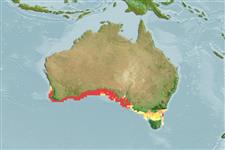>
Acropomatiformes (Oceanic basses) >
Pentacerotidae (Armorheads) > Histiopterinae
Etymology: Parazanclistius: Greek, para in the side of + Greek, za = an aumentative particle + Greek, agklino = to bo on one´s back (Ref. 45335).
Eponymy: Dr J Barry Hutchins (d: 1946) was Curator of Fishes at the Western Australian Museum (1998–2007), which he joined as a Technical Officer (1972) and where he worked until he retired. [...] (Ref. 128868), visit book page.
Environment: milieu / climate zone / depth range / distribution range
Ecologia
marinhas demersal; intervalo de profundidade 10 - 80 m (Ref. 9563). Subtropical
Eastern Indian Ocean: southern Western Australia. Has previously been confused with Zanclistius elevatus.
Tamanho / Peso / Idade
Maturity: Lm ? range ? - ? cm
Max length : 34.0 cm TL macho/indeterminado; (Ref. 9563)
Occurs on the continental shelf (Ref. 9563).
Ciclo de vida ou comportamento de acasalamento
Maturidade | Reprodução | Desova | Ovos | Fecundidade | Larvas
May, J.L. and J.G.H. Maxwell, 1986. Trawl fish from temperate waters of Australia. CSIRO Division of Fisheries Research, Tasmania. 492 p. (Ref. 9563)
Status na Lista Vermelha da UICN (Ref. 130435: Version 2024-2)
Ameaça para os humanos
Harmless
Uso pelos humanos
Ferramentas
Relatórios especiais
Baixar XML
Fontes da internet
Estimates based on models
Preferred temperature (Ref.
123201): 16 - 19.3, mean 17.4 °C (based on 96 cells).
Índice de diversidade filogenética (Ref.
82804): PD
50 = 1.0001 [Uniqueness, from 0.5 = low to 2.0 = high].
Bayesian length-weight: a=0.01995 (0.00906 - 0.04395), b=3.01 (2.83 - 3.19), in cm total length, based on all LWR estimates for this body shape (Ref.
93245).
Nível Trófico (Ref.
69278): 3.3 ±0.4 se; based on size and trophs of closest relatives
Resiliência (Ref.
120179): Baixo, tempo mínimo de duplicação da população 4,5 - 14 anos (Preliminary K or Fecundity.).
Fishing Vulnerability (Ref.
59153): High vulnerability (64 of 100).
